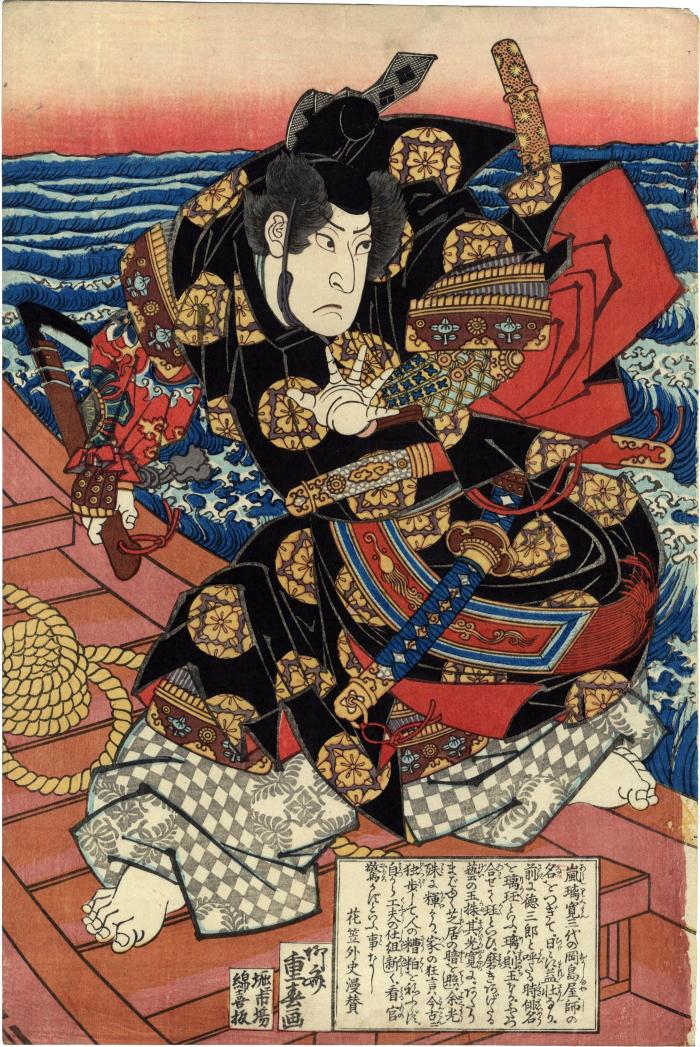Ryūsai Shigeharu (柳斎重春) (artist 1802 – 1852)
Arashi Rikan II (嵐璃寛) on a boat possibly as Fujiwara no Kamatari Daijin - the founder of the Fujiwara clan
1829
10 in x 15 in (Overall dimensions) Japanese woodblock print
Signed: Ryūsai Shigeharu ga
柳斎重春画
Publisher: Horie Ichiba Wataki Han (掘江市場綿喜坂), i.e. Wataya Kihei
Waseda University
Hankyu Culture Foundation
Lyon Collection - a companion piece This print is an odd case because some sources say it dates from 1829 and others from 1830. 1829 would make it an image of Arashi Rikan II, however, Arashi Rikan III's name and yagō Okajma-ya (岡島屋) appears at the beginning of the text below.
The text in the large cartouche reads:
嵐璃寛三代の岡島屋.師の名をつぎて.日々に益壮なり.前に徳三郎と呼たる時俳名を璃☆といふ.璃は則玉なり.ふたつ合せて☆といひ.磨きあげたる芸の玉株.其光寛に.あたりまばゆく芝居の暗を照し.余光殊に輝けり.家の狂言は今古ニ独歩して.人の糟粕をねふらず.自から工夫の仕組新しく.看官驚かずといふ事なし 花笠外史漫賛
****
Fujiwara no Kamatari (藤原鎌足: 614-669) was the founder of the Fujiwara clan.
****
Illustrated:
1) in color in Ikeda Bunko, Kamigata yakusha-e shūsei (Collected Kamigata Actor Prints), vol. 2, Osaka, 1998, no 122. Their information gives the publisher as Wataya Kihei.
2) in color in Schätze der Kamigata: Japanische Farbholzschnitte aus Osaka 1780-1880, MNHA (Musée national d'histoire et d'art Luxembourg), 2012, p. 240, #516. Also, a close-up full-page detail appears on page 200. The text in this catalogue describing this print and its mate suggests that Shigeharu was influenced by Kuniyoshi's Suikoden prints which began appearing two years earlier in 1827. In a description of this print and its accompanying pendent print the text says:
"Wie Kuniyoshi... zeigt Shigeharu einen Helden in bildausfüllender Figur in prächtigen Gewändernund in voller Rüstung in einer Kampfsituation. Während Kuniyoshi den Helden in einer Textartusche beschreibt, teilt Shigeharu in einer ähnlichen Textartusche ebenfalls informationen über "seinen Helden" mit, z.B. über sein Yago, Haigo oder seinen früheren Bühnennamen. Auch in der Signatur und Verlagskartusche folgt Shigeharu seinem Vorbild. Während der Held, den Utaemon III. verkörpert, ebenso wie sein bezwungener Gegner noch unbekannt ist, so Rikan II. den Begründer des Fujiwara-Clans und Staatsminister Kamatari Danjin darstellen."
The Google translation is:
"Like Kuniyoshi..., Shigeharu shows a hero with a full-figure figure in magnificent robes and full armor in a combat situation. While Kuniyoshi describes the hero in a text cartridge, Shigeharu also shares information about "his hero" in a similar text cartridge, e.g. about his Yago, Haigo or his former stage name. Shigeharu also follows his example in the signature and publishing cartouche. While the hero, Utaemon III. embodied, just as his defeated opponent is still unknown, so Rikan II represents the founder of the Fujiwara clan and state minister Kamatari Danjin."
****
This may well represent a performance at the Horie Ichinogawa theater and is the companion piece to another print in the Lyon Collection, #29.
Kyōto-Osaka prints (kamigata-e - 上方絵) (genre)
actor prints (yakusha-e - 役者絵) (genre)
Arashi Rikan II (二代目嵐璃寛: 9/1828 - 6/1837) (actor)
Wataya Kihei (綿屋喜兵衛) (publisher)
